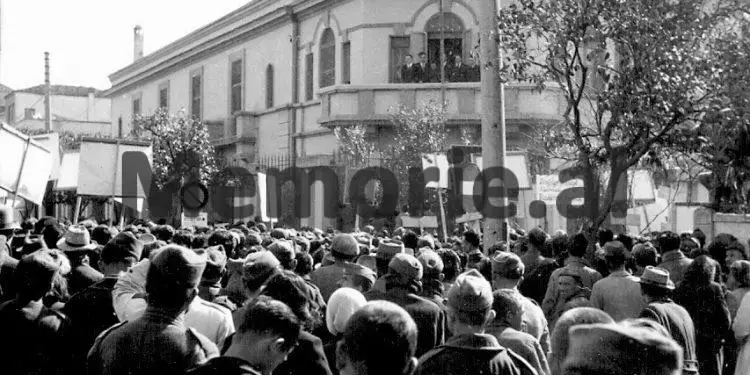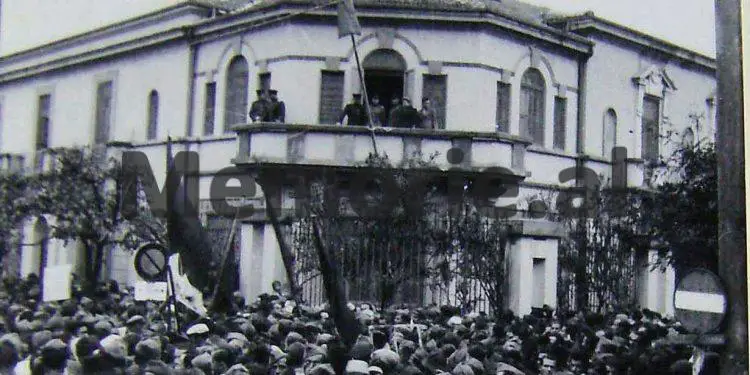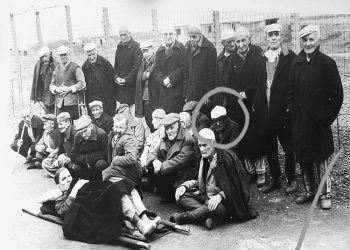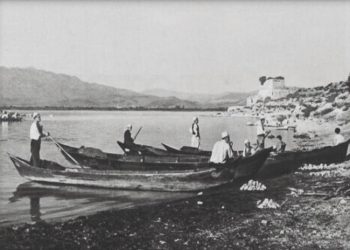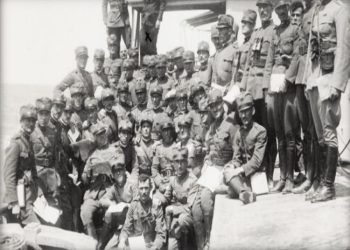Memorie.al publishes for the first time two rare photos of the building of the former USSR embassy (Union of Soviet Socialist Republics) in Tirana located on ‘Durrës Street’, where today is the Ministry of Education, photos of which belong to the early 1950s, and clearly show large popular manifestations, typical of communist regimes that were made for propaganda purposes.
These events were often organized by the “Albania-USSR Friendship Organization”, and were attended by senior exponents of the ALP leadership and various Soviet diplomats accredited in Tirana, such as Ambassador Çuvakin, Military Attaché Sokolov, etc. as seen in these images, on the balcony of the second floor of the embassy headquarters.
But this “warm climate” of friendship would be “shaken” at midnight on February 19, 1951, when two dynamite molds were thrown in the yard of this embassy. The explosion of explosives (dynamite) would cause minor damage, which would only consist of breaking some embassy windows.
According to the official version of that time, this act was committed by Hysen Llulla and Qazim Laçi, two members of the anti-communist organization “National Union” led by Hamdi Frashëri, which at that time was all under the control of the State Security. Also, according to some sources, it is known that the State Security itself, with the ‘blessing’ of the senior communist leadership, staged this event, to then undertake the strike against the “enemy element”, as it happened afterwards.
All this was done by Enver Hoxha, to show Stalin and the “Soviet brotherly people” their great loyalty to them. According to the official version, the two “perpetrators of the bombing”, Hysen Llulla and Qazim Laçi (who did not know that it was a State Security game), would be identified, arrested, and executed shortly.
The day after the “bomb incident at the Soviet embassy”, an urgent meeting was held at the Ministry of Internal Affairs, where the General Director of the State Police, Sali Ormëni, who also held the post of Deputy Minister of Internal Affairs., not only did not acknowledge the ‘lack of vigilance of the police forces that did not secure the embassy’, but openly stated that it was a State Security game.
After that meeting, he was considered a person who had gone through “nervous concussion” and was forcibly hospitalized in the Psychiatric Hospital in Tirana, with strict security measures, and a few days later he was found dead in the forests of Elbasan. The official version was “suicide” and in a long meeting, the Plenum of the Central Committee chaired by Enver Hoxha, declared him “an enemy of the people, who had committed suicide to cover up the betrayal”?!
But this event, the “bomb incident at the Soviet embassy”, would not end there! On February 20-21, 1951, the Politburo would lightly hold an extraordinary meeting to discuss the harsh draconian measures that would be taken against the “enemy element” in the capital.
Among the most radical in that meeting of the Politburo, was Major General Mehmet Shehu, who at that time held the post of Minister of Internal Affairs, who in his speech, among other things, said: “After what happened to us, we must undertake a strong blow to the enemy element, shooting even without trial, as we did in the case of the murder of comrade Bardhok Biba in Mirdita in 1949 ”
At the end of the meeting and the decisions taken there unanimously, numerous State Security forces and the Police, in a demonstrative manner, would arrest nearly 200 people, taking them overnight from their homes in several neighborhoods of the capital. They were mainly intellectuals, merchants, and former soldiers of the period of the Zog Monarchy and the occupation of the country (1939-1944) and after a formal two-three-day investigation, which took place at the premises of the Directorate of Internal Affairs Tirana, (at ‘Selvija’), 22 of those arrested were selected to be shot.
Their execution took place in the late hours of the night of February 26-27, 1951, in a place called “Ura e Beshirit”, somewhere on the outskirts of Tirana. Among those executed was Sabiha Kasimati, originally from the city of Gjirokastra, a well-known intellectual with a degree in Biology-Chemistry in France, who was a former classmate of Enver Hoxha while studying together at the Korça High School.
The macabre execution of 22 completely innocent Albanian intellectuals would be carried out without any final, even formal, court decision, which would be the only case in the 45 years of the dictatorship of the communist regime of Enver Hoxha, that a number of so large persons, would be shot without a court order!
This, which was rumored at the time, was officially confirmed only after the 1990s with the opening of the secret archives of that regime, where for the event in question, an attempt was made to fill in some documents, as if a trial had been held for 22 people were shot, but the signatures of some of the judges were missing, who had refused to sign, as their execution had become a fact!
The joint pit with the remains of 22 people shot near the Beshir Bridge was found in the year thanks to two villagers in the area who had witnessed the execution of the victims on the night of February 27 and their reburial was done with a state ceremony at the Cemetery of ‘ Martyrs of the Nation ‘, being placed in a common grave, while on the perimeter wall of the former headquarters of the Soviet embassy (today the Ministry of Education and Science), a memorial plaque was placed with the names of 22, shot, victims of communist regime. /Memorie.al




